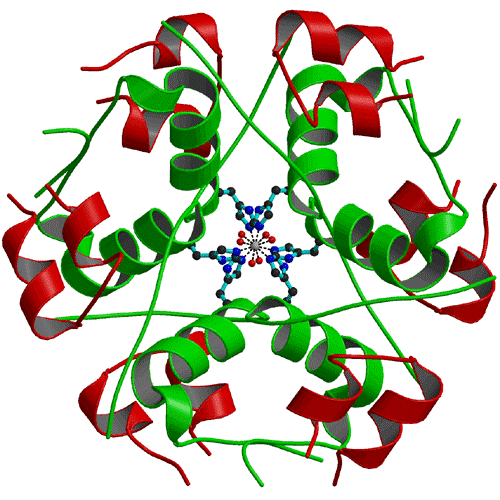Description
 Bovine Insulin, or beef insulin, is a two-chain polypeptide hormone produced in vivo in the pancreatic β cells and it is the most studied hormone. Insulin regulates glucose uptake into muscle and fat cells by recruiting membrane glucose transporter Glut-4 to cell surface. Understanding how insulin regulates the movement of Glut-4 will lead to the development of new therapy to treat type II diabetes. Insulin also influences other body functions, such as vascular compliance and cognition. Insulin enhances learning and memory once it enters human brain and benefits verbal memory in particular.
Bovine Insulin, or beef insulin, is a two-chain polypeptide hormone produced in vivo in the pancreatic β cells and it is the most studied hormone. Insulin regulates glucose uptake into muscle and fat cells by recruiting membrane glucose transporter Glut-4 to cell surface. Understanding how insulin regulates the movement of Glut-4 will lead to the development of new therapy to treat type II diabetes. Insulin also influences other body functions, such as vascular compliance and cognition. Insulin enhances learning and memory once it enters human brain and benefits verbal memory in particular.Bovine Insulin has often been used as growth supplement in culturing cells at the concentration ranging from 1 to 10 micrograms per milliliter of medium. The amino acid sequence of insulin is extremely well preserved. Bovine insulin differs from human insulin in only three amino acid residues, similar enough to be clinically effective in humans.
Details
| Cat. Nos. (& Qty.): | 128-100 (100 mg), 128-1000 (1000 mg), 128-10g (10 g), Inquire Re: Bulk |
| Source: | Bovine Pancreas |
| Physical Appearance: | Powder |
| CAS No.: | 11070-73-8 |
| Potency: | > 25 USPU/mg |
| Storage: | Store stock vials of bovine insulin at -20°C in a non frost-free freeze. Do not thaw and refreeze insulin. Store thawed insulin at 4°C. |
| Suggested Usage: | 1 to 10 microgram bovine insulin per milliliter of medium |
| Quality Control: | Cell culture tested; 5 μg/ml of bovine insulin support robust growth of human keratinocytes |
| Reconstitution: | 1. Equilibrate bottle or vial of bovine insulin to room temperature. 2. Briefly spin down bovine insulin powder in the bottle or vial. 3. Dissolve bovine insulin by adding acidified water at pH 2.0 along the sides of bottle or vial to ensure full recovery of insulin: 10ml to 100mg vial 100ml to 1000mg bottle 4. Mix bovine insulin gently to make a homogeneous solution.5. Sterilize Bovine Insulin Stock Solution by filtering 10 ml through a syringe filter (0.2 μm pore size) and filtering 100ml through a 100ml filter unit (0.2 μm pore size).6. Aliquot single use aliquots in sterile vials as stock solution. |
Products
| Product | Size | CAT.# | Price | Quantity |
|---|---|---|---|---|
| Bovine Insulin: Bovine Insulin tested for cell culture | Size: 100 mg | CAT.#: 128-100 | Price: $384.00 | |
| Bovine Insulin: Bovine Insulin tested for cell culture | Size: 1000 mg | CAT.#: 128-1000 | Price: $3,570.00 | |
| Bovine Insulin: Bovine Insulin tested for cell culture | Size: 10 g | CAT.#: 128-10g | Price: $0.00 |
Publications
2017
Luchun Li, Yan Li, Lulu Wang, Zhijuan Wu, Huiwen Ma, Jianghe Shao, Dairong Li, Huiqing Yu, Weiqi Nian, Donglin Wang. 2017. Inhibition of Hes1 enhances lapatinib sensitivity in gastric cancer sphere-forming cells. Oncology Letters. https://doi.org/10.3892/ol.2017.6683.
2016
Ryoo, I., G. Kim, B. Choi, S. Lee and M. Kwak. 2016. Involvement of NRF2 Signaling in Doxorubicin Resistance of Cancer Stem Cell-Enriched Colonospheres. Biomol Ther, 24:482–488.
Stowers, R., S. Allen, K. Sanchez, C. Davis, N. Ebelt, C. Van Den Berg and L. Suggs. 2016. Extracellular Matrix Stiffening Induces a Malignant Phenotypic Transition in Breast Epithelial Cells. Cellular & Molec Bioeng, doi:10.1007/s12195-016-0468-1.
Wang, H., M. Becuwe, B. Housden, C. Chitraju, A. Porras, M. Graham, X. Liu, A. Thiam, D. Savage, A. Agarwal, A. Garg, M. Olarte. Q. Lin, F. Fröhlich, H. Kristian, H. Hannibal-Back, S. Upadhyayula, N. Perrimon, T. Kirchhausen, C. Ejsing, T. Walther and R. Farese. 2016. Seipin is required for converting nascent to mature lipid droplets. eLife, 5:e16582.
2015
Curran, C., E. Carrillo, S. Ponik, and P. Keely. 2015. Collagen density regulates xenobiotic and hypoxic response of mammary epithelial cells. Environmental Toxicol and Pharmacol, 39:114-124.
2014
Chaudhury, A., N. Kongchan, J. Gengler, V. Mohanty, A. Christiansen, J. Fachini, J. Martin and J. Neilson. 2014. A piggyBac-based reporter system for scalable in vitro and in vivo analysis of 3′ untranslated region-mediated gene regulation. Nucleic Acids Res, 42:e86.
Höfig, I. S. Barth, M. Salomon, V. Jagusch, M. Atkinson, N. Anastasov, and C. Thirion. 2014.Systematic improvement of lentivirus transduction protocols by antibody fragments fused to VSV-G as envelope glycoprotein. Biomaterials, 35:4204-4212.
Kooistra, R. 2014. Functional Characterization of a Novel Thioredoxin Domain-Containing Protein of the Malaria Parasite Plasmodium. Loyola U, MS Thesis, http://ecommons.luc.edu/luc_theses/2506.
Kumar, S., D. Kumar, K. Raina, R. Agarwal, and C. Agarwal. 2014. Functional modification of adipocytes by grape seed extract impairs their pro-tumorigenic signaling on colon cancer stem cells and the daughter cancer cells. Oncotarget, 5:10151–10169.
Tomblin, J. and T. Salisbury. 2014. Insulin like growth factor 2 regulation of aryl hydrocarbon receptor in MCF-7 breast cancer cells. BBRC, 443:1096-1098.

